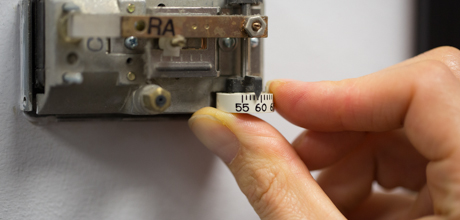Eighty percent of George Washington University’s carbon footprint comes from activities conducted in campus buildings.
That’s why GW has launched the Eco-Building Program, which aims to reduce energy consumption and greenhouse gas emissions by improving the energy and water systems of campus buildings and modernizing equipment.
The program, which began in July, has already made renovations in Gelman Library, Lisner Auditorium and the Marvin Center, among other buildings.
"The Eco-Building Program is a true innovation for GW,” said Alicia Knight, senior associate vice president for operations. “Though it does require financial investment, the program improves buildings and saves money that can be redirected to academic programs. Even better, it’s further integrating GW’s sustainable efforts into many university departments with a result of many new sustainable features on our campus. It's a win-win."
The university, which is investing $5.3 million in the program, expects to reduce energy use by up to 6.9 million kilowatt hours – the equivalent of removing a large building or two large residence halls from campus. These renovations will help GW meet its goal of reducing its carbon emissions by 40 percent by 2025 and becoming carbon neutral by 2040.
The idea for the program came from the Innovation Task Force, a committee launched by President Steven Knapp in 2009 to identify cost savings and new revenue for reinvestment in the university’s top academic priorities. The university’s Facilities Services and the Office of Sustainability partnered to implement and manage the Eco-Building Program on a block-by-block basis throughout the Foggy Bottom Campus.
The first phase of the program has included making renovations in 12 buildings on the H Street block between 21st and 22nd streets such as replacing or updating old and inefficient heating and cooling systems; installing occupancy sensors, window film and smart power strips; and upgrading to more energy-efficient lighting.
“Facilities Services is implementing these Eco-Building retrofits in order to update and modernize buildings across the GW campus,” said Jim Schrote, director of facilities management. “We work closely with the Office of Sustainability on an ongoing basis, and we are happy to see that these retrofits align well with GW's campus sustainability goals.”
The university expects most of the lighting and other simpler projects will be completed by December, while the more extensive renovations in Gelman are expected to be finished by the end of 2013.
"I want to commend GW's Facilities Services for taking leadership on implementing the Eco-Building Program. Only with their commitment and hands-on skills are we able to make GW a sustainable university,” said Meghan Chapple-Brown, director of the Office of Sustainability. “The building equipment retrofits--and occupant behavior--are key to helping GW reach its climate change and water sustainability goals."


